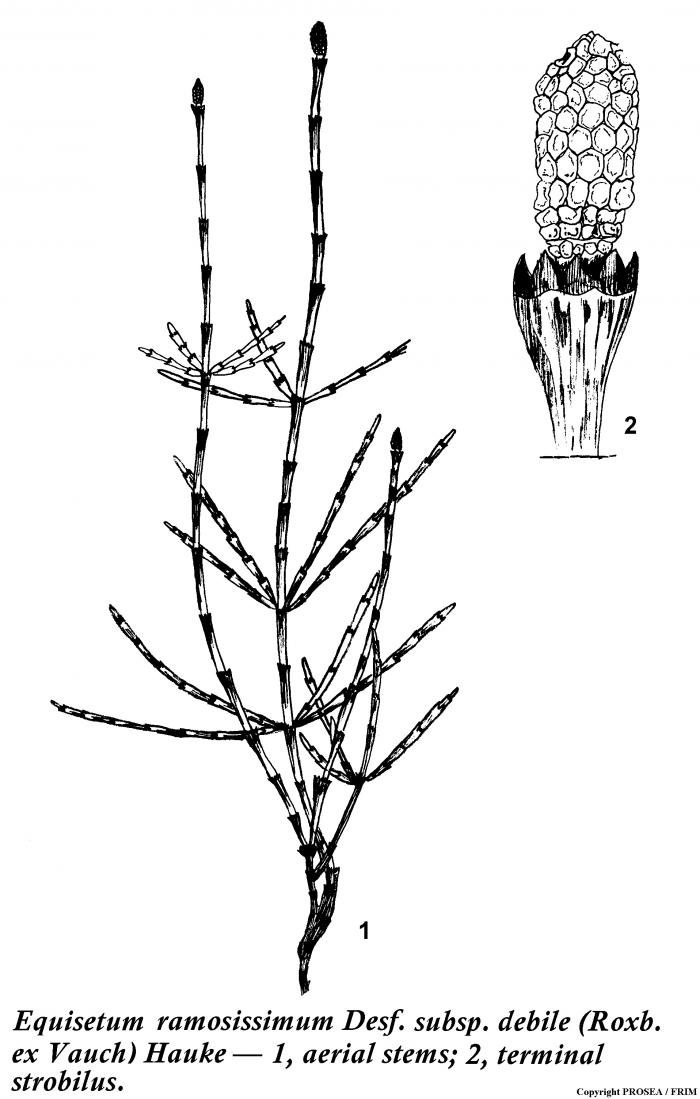Scientific Name
Equisetum ramosissimum subsp. debile (Roxb. ex Vaucher) Hauke
Synonyms
Hippochaete ramosissima subsp. debilis (Roxb. ex Vaucher) Á. Löve & D. Löve [1]
Vernacular Name
| English | Horsetail, weak horsetail [2] |
| China | Tu muzei [2] |
| India | Gathi singa, hadjuri,harjora, kurkure jhar, nikshu, ningmat, soojigandhi [2] |
| Nepal | Kurkure, simdhurgi [2] |
Geographical Distributions
Equisetum ramosissimum is widespread, from Southern and Eastern Africa, southern and Central Europe throughout Asia to Central and South America. In Southeast Asia only subsp. debile (Roxb. ex Vauch.) Hauke is found. [3]Botanical Description
E. ramosissimum is a very characteristic plant with jointed, hollow stems, branches in whorls around the stem, apparently without leaves and spores produced in a terminal and with cone-like strobilus. [3]
The stem is irregularly branched or simple, erect or ascending, cylindrical, with a size of measuring 15-300(-900) cm x 2-3(-15) mm, articulate with hollow internodes, smooth and evergreen (green to greyish-green in colour). The ridges are 10-32, convex, usually with small cross-bands of silica and grooves with flat-topped rosettes. The stomata are arranged in one line on each side of the groove. They are measure 71-102 µm x 56-78 µm. The branches are solitary or in groups of 2-3(-5), erect, straight or sinuous, simple or occasionally branched, up to measure 60 cm long and with 6-10 ridges. [3]
The leaves are small, scale-like and they are in whorls that fuse into a sheath at the stem nodes. The sheath is cylindrical to slightly funnel-shaped, with a size measure 4.5-13 mm x 2-12 mm, smooth segments, prominent basally midrib, becomes flattened apically, with 2 distinct lateral ridges, flattened ribs, angular at the sides, green, thin teeth, with a brown central band and white or colourless margins, drying or deciduous and leaves a truncated margin on the sheath. The sheath of the branches is like the ones of the stem or retains the teeth where the first internode is much shorter than the corresponding stem sheath. [3]
The strobilus is cone-like, ellipsoid in shape, up to measure 17 mm x 7 mm, subobtuse to apiculate with measure 1 mm apiculum and it is yellow to black in colour. [3]
The sporangiophore consists of a short stalk at right angle to the axis of the strobilus and peltately attached to a plate-like and flat. The hexagonal structure bears 5-10 sporangia on its underside. The spores are spherical. [3]
The rhizome is rather deep underground, erect or ascending, with many ascending and dark brown to black branches. It is somewhat rough and with 6-8-sectored. The roots are numerous and wiry along the length of the rhizomes. [3]
Cultivation
E. ramosissimum is found in marshes and abandoned rice fields, in meadows along streams or trails, or attached to rocks in streams, from humid lowlands up to severe alpine conditions at 3600 m altitude. The stem may remain tufted and small when growing in sandy soils along river banks, but attains a height of several m when growing in shady and swampy soils of forests. It may profit from soil disturbance, for example by logging or the establishment of plantations. It has become a weed that thrives gregariously on the rice terraces of the Philippines and in the tea plantations of Sumatra. [3]
Chemical Constituent
No documentation
Plant Part Used
No documentation
Traditional Use
No documentation
Preclinical Data
No documentation
Clinical Data
No documentation
Poisonous Management
No documentation
Line Drawing

References
- The Plant List. Ver1.1 Equisetum ramosissimum subsp. debile (Roxb. ex Vaucher) Hauke [homepage on the Internet]. c2013 [updated 2012 Apr 18; cited 2015 Jun 10] Available from: http://www.theplantlist.org/tpl1.1/record/tro-26613529
- Quattrocchi UFLS. CRC World Dictionary of Plant Names: Common names, scientific names, eponyms, synonyms, and etymology. Volume III E-L. Boca Raton, Florida: CRC Press; 2012. p. 83-84.
- de Vinger WP, Amroso VB, editors. Plant Resources of South-East Asia No.15(2): Cryptogams: Ferns and fern allies. Leiden, Netherlands: Backhuys Publishers; 2003.


